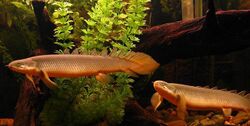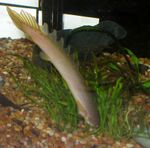Biology:Polypterus senegalus
| Polypterus senegalus | |
|---|---|

| |
| Scientific classification | |
| Domain: | Eukaryota |
| Kingdom: | Animalia |
| Phylum: | Chordata |
| Class: | Actinopterygii |
| Order: | Polypteriformes |
| Family: | Polypteridae |
| Genus: | Polypterus |
| Species: | P. senegalus
|
| Binomial name | |
| Polypterus senegalus Cuvier, 1829
| |
| Subspecies | |
| |
| Synonyms[2][3] | |
| |
Polypterus senegalus, the Senegal bichir, gray bichir or Cuvier's bichir, and sometimes called the "dinosaur eel" (a misnomer, as the creature is neither an eel nor a dinosaur), "dinosaur bichir", or "dragon fish" is in the pet trade due to its lungfish-like appearance, which was described as more primitive and prehistoric than other modern fishes. It is a prototypical species of fish in the genus Polypterus, meaning most of its features are held across the genus. It is commonly kept in captivity by hobbyists. They are native from Africa where they are the most widespread species of the genus.[4][5][6][7][8]
Appearance
Polypterus senegalus is an elongated fish, usually grey or beige in color, though it sometimes has shades of white, pink or blue on some of its rhomboid-shaped, multilayer scales. Most of the fish is covered in very subtle patterns with occasional darker blotches or dots. At the nose, the face is smooth and rounded, with larger scales than the rest of the fish. External nostrils protrude from the front. Eyes are on each side of the head, and they are usually pale yellow with a black pupil. P. senegalus has poor eyesight, and relies on sense of smell when hunting prey.[6] The mouth is large and appears to grin when closed. The dentary, premaxilla, and maxilla each carry one row of large, slightly recurved teeth.[4] There are multiple rows of smaller teeth, found between the rows of large teeth, on the prearticular and coronoids in the lower jaw and on the bones forming the roof of the mouth.[4]
The body is long and vaguely cylindrical; a serrated dorsal fin runs along most of the body until it meets the caudal fin, which is pointed and flat. There are 8-11 dorsal spines and 14-17 anal spines.[8] The pectoral fins attach just behind and below the gill openings, and are the primary means of locomotion, providing a slow, graceful appearance. P. senegalus is smaller than other bichirs, reaching about 35.5 cm (14 in). This fish exhibits sexual dimorphism, where the males are generally smaller than the females and have a thicker anal fin.[8]
The fish has a pair of primitive lungs instead of a swim bladder, allowing it to periodically gulp air from the surface of the water. In the aquarium, bichirs can be observed dashing to the surface for this purpose. Juvenile P. senegalus have external gills that disappear as they age.
This bichir's skin serves as a particularly effective armor, and has been studied as a model for personal armor for better combinations of protection and mobility.[9][10]
Reproduction
Polypterus senegalus breed during the rainy season in nature. During courtship, the male chases and nudges the female. The females lays 100-300 eggs within a few days. The male receives the eggs from the female by cupping his anal and caudal fins around her genitals. The male then fertilizes the eggs and scatters them in the vegetation. Egg hatching can take 3-4 days.[5]
Feeding
Polypterus senegalus feed on small vertebrates, insects, and crustaceans.[8] They use suction feeding to ingest prey from the bottom of freshwater lakes and rivers.[4] P. senegalus is said to consume anything it can swallow, which is why it is recommended that their tankmates be at least half of their size.[7] They are opportunistic ambush predators, moving slowly and cautiously, and occasionally hiding, to capture their prey.
Behavior
During active hours, Polypterus senegalus swim about their environment, performing activities such as exploring, feeding, hunting, investigating changes, and scavenging. Social behavior is also observed, as P. senegalus sometimes follow each other moving about. Most individuals are inactive at night and rest low above the ground until sunrise.[citation needed]
Subspecies
Three subspecies of P. senegalus are recognized: P. s. senegalus, P. s. meridionalis, and a further unnamed subspecies.[citation needed]
- P. s. senegalus grows to about 70 cm (28 in) in the wild, and 48 cm (19 in) in captivity. It is a uniform brownish-grey to olive color on the dorsal surface, and the ventral surface is whitish. No banding occurs on adults, but very young juveniles show three horizontal bands. The upper jaw is slightly longer than lower jaw. It has eight to 11 dorsal finlets.[citation needed]
- P. s. meridionalis grows to about 110 cm (44 in) in the wild, and 81 cm (32 in) in captivity. It is a uniform olive-grey color on the dorsal surface. The upper and lower jaws are about the same length. It has 9 or 10 dorsal spines. P. s. meridionalis may be a regional variant of P. s. senegalus.[citation needed]
Distribution and habitat
This species of bichir is found in lakes, river margins, swamps, and floodplains of tropical Africa and the Nile river system, it occurs in at least twenty-six African countries which include Senegal, Egypt, Democratic Republic of Congo, Cameroon, Chad, Ethiopia, Kenya, Mali, Ivory Coast, Tanzania, Sudan, Nigeria, Gambia, Uganda, and others. Its distribution is widespread, detailed to include the Nile basin and West Africa (Senegal, Gambia, Niger, Volta, and Lake Chad basins, and Congo River Basin.[citation needed]
Provided the skin remains moist, P. senegalus can remain out of the water indefinitely – it can even be raised on land, where it uses its large pectoral fins to walk.[11]
Captivity
Bichirs are predatory fish; in captivity they will take any live or dead animal that can be swallowed or broken apart and then swallowed. Only its lack of speed prevents a bichir from emptying an aquarium of smaller fish. The pectoral fins only allow for slow cruising, and while it can achieve amazing bursts of speed, it cannot catch fish of average speed. Given enough time, any fish that can fit in the bichir's mouth will be eaten. This fish should not be kept with any other fish smaller than three inches. It will also bite fins of other fishes if it can. [citation needed] P. senagalus can reach 10-15 years of age in captivity.
See also
- List of freshwater aquarium fish species
References
- ↑ Lalèyè, P. (2020). "Polypterus senegalus". IUCN Red List of Threatened Species 2020: e.T182615A58331540. doi:10.2305/IUCN.UK.2020-2.RLTS.T182615A58331540.en. https://www.iucnredlist.org/species/182615/58331540. Retrieved 19 November 2021.
- ↑ Froese, R.; Pauly, D. (2017). "Polypteridae". http://www.fishbase.se/Summary/FamilySummary.php?ID=31.
- ↑ "Polypteridae". http://deeplyfish.com/wp-content/uploads/2017/05/Family-Polypteridae-PDF.pdf.
- ↑ 4.0 4.1 4.2 4.3 Berkovitz, Barry; Shellis, Peter (2017). The Teeth of Non-Mammalian Vertebrates. Academic Press. pp. 43-111. ISBN 9780128028506. https://doi.org/10.1016/B978-0-12-802850-6.00004-7. Retrieved 26 April 2021.
- ↑ 5.0 5.1 Khardina, Natasha. "Polypterus senegalus". https://biotopeaquariumproject.com/fish/polypterus-senegalus-kdsoleimani/.
- ↑ 6.0 6.1 "Polypterus senegalus – Grey Bichir – Senegal Bichir". https://aquainfo.org/polypterus-senegalus-grey-bichir-senegal-bichir/.
- ↑ 7.0 7.1 Milner, James. "Dinosaur Bichir: Care and Feeding for the Polypterus Senegalus Fish". https://theaquarium.club/polypterus-senegalus/.
- ↑ 8.0 8.1 8.2 8.3 Cruz, Tess. "Polypterus senegalus". https://www.fishbase.de/summary/Polypterus-senegalus.html.
- ↑ "Threat-protection mechanics of an armored fish.". J Mech Behav Biomed Mater 4 (5): 699–712. July 2011. doi:10.1016/j.jmbbm.2010.11.011. PMID 21565718.
- ↑ "Materials design principles of ancient fish armour". Nature Materials 7 (9): 748–56. September 2008. doi:10.1038/nmat2231. PMID 18660814.
- Sara Reardon (23 January 2013). "Body armour to scale up by mimicking flexible fish". New Scientist. https://www.newscientist.com/article/mg21729016.000-body-armour-to-scale-up-by-mimicking-flexible-fish.html.
- ↑ "Developmental plasticity and the origin of tetrapods". Nature 513 (7516): 54–8. August 2014. doi:10.1038/nature13708. PMID 25162530.
External links
- Froese, Rainer and Pauly, Daniel, eds. (2005). "Polypterus senegalus" in FishBase. May 2005 version.
- "Polypterus senegalus". Integrated Taxonomic Information System. https://www.itis.gov/servlet/SingleRpt/SingleRpt?search_topic=TSN&search_value=573243.
- Senegal Bichir – Polypterus senegalus, BioFresh Cabinet of Freshwater Curiosities.
- Fish scales may point to armor of the future
- Dinosaur eel inspires bulletproof armor
- Care information for Senegal Bichir at The Aquarium Wiki
- Duhaime-Ross, Arielle (August 27, 2014) "Scientists raised these fish to walk on land". The Verge. Retrieved April 12, 2017.
- Polypterus senegalus at Encyclopedia of Life.
Wikidata ☰ Q1515914 entry
 |






